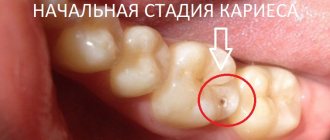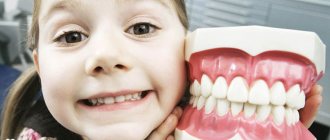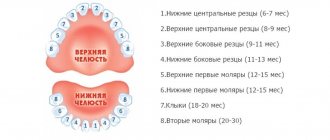Ideal teeth size
In dentistry, teeth of a certain size and anatomical shape are considered normal, depending on the size of the jaw and their location in it. They must be smooth, fit tightly to each other and have a thickness within certain limits: for example, the height of the lateral incisors in an adult is normally 7 - 11 millimeters. Of course, this does not mean that they need to be measured with a ruler - overall aesthetics and proportionality are much more important (for example, for people of short stature and fragile build, a small teeth size is appropriate). Many parents are interested in why their child has small teeth, but usually there is no reason to worry: normally, the baby incisors are small and located at a distance from each other.
However, if the patient really has very small teeth, you should definitely consult a dentist to confirm or exclude the diagnosis of microdentia.
Anomalies in tooth shape
In orthodontics, the most common concept is considered to be “malocclusion”, that is, the closing of the jaws and the position of the teeth at the same time. However, the beauty of our smile is also affected by the irregular shape of the teeth - for example, when they are of different sizes, rotated around their axis, or shifted to one point.
Changes in the shape of teeth, violation of their position are also anomalies of the dental system, but, like malocclusion, they are treatable.
EXPERT OPINION
Correction of bite with internal braces Win - 180,000 rubles.
All inclusive! Preparation and treatment of the oral cavity, consultation with an orthodontic specialist, installation and adjustment of orthodontic structures. The price is for one jaw.
Free consultation with an orthodontist +7 (495) 789-39-31 or write to us
Diagnosis of microdentia
According to statistics, about 5% of people face the problem of microdentia – abnormally small teeth in an adult. There are several signs that allow you to distinguish microdentia from other dental pathologies.
Symptoms of microdentia
- teeth of regular shape, but with a significantly reduced crown;
- distances between teeth visible to the naked eye;
- damage mainly to the front teeth;
- wavy or jagged shape of the cutting part of the affected tooth.
In most cases, the presence of microdentia can be determined by visual examination of the patient, but for a more accurate diagnosis, hardware diagnostics are performed. For example, the doctor can measure the overall width of the incisors of both jaws using a special instrument, as well as resort to x-rays. A deviation is considered to be a reduction of teeth by 1.5 mm or more relative to the norm. Based on the results of the examination, one of three types of microdentia is determined.
Isolated
If the patient has one or two small teeth, then we are talking about isolated microdentia. Most often, the front incisors (mainly the lateral incisors) are underdeveloped.
Relative
Relative microdentia is said to occur when the patient has an abnormally enlarged jaw. On such a jaw, even normal-sized crowns can look disproportionately small. Thus, relative microdentia is an overly large gum and small teeth on it.
Generalized
In the most severe cases, when small teeth are located throughout the jaw, the patient is diagnosed with “generalized microdentia.”
What types of teeth are there: irregular shape
- oversized teeth: these are overly large teeth that can interfere with the eruption of neighboring ones, distort the dentition and cause crowding of teeth. Most often, the problem concerns the front teeth (the so-called “bunny smile” occurs), the size of which can be increased up to 6 mm in length relative to the rest in the row. One of the most serious disadvantages of giant teeth is their abnormal appearance, which attracts unnecessary attention and does not meet generally accepted standards of beauty.
- Too small teeth: This is a problem in which the jaw contains teeth with small crowns. The problem often spreads to all the teeth in the mouth. The teeth may be regularly shaped but often grow at large intervals. In addition, due to the too small size, the teeth of the upper and lower jaws do not meet tightly, as a result of which the patient has problems chewing solid food, since the chewing surfaces of the opposite teeth do not connect,
- teeth in the form of spikes: that is, wide at the base (at the gums) and very narrow in width at the tips, in the form of a spike or cone,
- teeth of any abnormal shape: they have a wide variety of irregular shapes that cannot be structured or described,
- Hutchinson's teeth: teeth that are wider at the base and narrower in thickness at the cutting edge. The problem usually affects the front teeth of the upper or lower jaw. The lower cutting edge also has a small semicircular notch (it is this feature that the scientist characterized as one of the main ones for determining congenital syphilis). On the lower cutting side there is often no enamel and the inner dentin of the tooth is exposed,
- Fournier teeth: similar to Hutchinson teeth, that is, they are shaped like a flat-head screwdriver. But Fournier proved that in the presence of congenital syphilis, there may not be a semicircular notch on the cutting surface of the front teeth,
- Pflueger teeth: the problem affects only the first chewing molars. Outwardly, they resemble an unopened bud - that is, they are greatly underdeveloped in size.
Reasons why teeth become small
As a rule, most of the reasons leading to the appearance of small front teeth in adults come from childhood, when pathological processes interfere with the formation of body systems. Microdentia can be a consequence of:
- severe infections suffered before the age of 2 years;
- exposure to radiation;
- inflammatory diseases in the mother during pregnancy;
- early removal of baby teeth;
- underdevelopment of the alveolar ridge and, as a consequence, lack of sufficient support for “growing” teeth of normal size.
How to choose the color of veneers
Choosing the right shade for the overlays is perhaps the most important part of the process. You can make veneers ideal in shape, carefully convey the details, but without the right color you will not get a satisfactory result.
Teeth onlays are made from materials that have properties as close as possible to natural enamel. This means that they have (to a greater or lesser extent) the ability to transmit light - to shine through. Therefore, the color of the dentin (the layer under the enamel) will be reflected in the final color of the plate. The shade of the cement on which the veneer is fixed will also make its contribution.
The colors of ceramic veneers are selected using the Vita scale
. In total, it contains 20 colors: 16 of them are natural, and 4 are ultra-white (Bleach). Bleach is an unnatural color; there are no natural teeth of this color.
There are 4 blocks in the scale, each with its own shade:
- Block A
includes red-brown shades - Block B
- yellow-red - Block C
- grayish - Block D
- gray-red
Decoding shades shouldn't be scary. In fact, they all look like natural enamel, and the designations are only important for specialists.
The main characteristic of color is brightness. Therefore, each block presents 4 degrees of brightness of each shade. From the brightest, it is indicated by the number 1, to the dimmer, under the number 4. The color of the veneer is a1
means that it should be the brightest color in the reddish-brown range. There are no shades in the bleach color of veneer 1 or 2, only white. There is a certain amount of yellow in Bleach 3 and 4, but the entire palette immediately speaks of the artificial origin of the color.
Dangerous consequences of microdentia
At first glance, it seems that small teeth in an adult cause only aesthetic inconvenience, but this is not so. Dentists identify several quite serious problems that microdentia can lead to.
- Distal displacement of teeth,
that is, their gradual shift back relative to the optimal position in the jaw. - The appearance of gaps between the teeth
(the so-called diastemas and threes), which lead to disruption of the contact of the lateral surfaces of the teeth. Without support, the ligaments in the dental bed stretch and the tooth becomes unstable. - Diction disorders,
excessive amplification of hissing and whistling sounds in speech. - Periodontal disease
is a disease of the soft tissues of the jaw, caused by accumulations of bacteria in the interdental spaces and an enlarged periodontal pocket due to the high mobility of the tooth.
Possible consequences if left untreated
The front incisors, which are slightly longer than the others, do not cause any problems to a person and are even an object of fashion. This is due to the fact that enlarged crowns give the face a more youthful appearance and are not always an aesthetic flaw. Pathological enlargement of dental elements leads to unpleasant consequences.
- Very wide teeth can push, twist, and protrude beyond the row because there is not enough room for them. An abnormal bite develops, affecting not only the beauty of the smile, but also the digestive processes.
- If a child has a very large molar, it can become an obstacle to the eruption of neighboring elements.
- If the incisors have become larger over time, and were not this way from birth, then this indicates problems with the gums. In such a situation, before fixing the teeth, it is necessary to treat the gum tissue.
- Speech is distorted under the influence of pathologically large dental elements.
- A person with such a defect experiences psychological discomfort. He avoids communication and does not smile or does it very stiffly, controlling the process.
How to fix small teeth?
Small tooth: what to do if it causes inconvenience, reduces self-esteem and worsens quality of life? Depending on the severity of the picture, the dentist may suggest the following correction methods:
- In case of isolated microdentia, small teeth can be corrected by installing veneers or lumineers - thin plates that are attached to the front surface of the tooth. This method is also suitable for eliminating threes and diastemas and increasing the width of the visible part of the crown. If your teeth grow unevenly, you will most likely need orthodontic correction using braces before placing veneers.
Celebrities with big teeth
Celebrities often have large front central incisors. They give the image something special and unusual. Such a smile makes a person stand out from the rest. The list of public figures with large incisors:
- Hilary Swank;
- Steve Tyler;
- Jon Heeder;
- Ann Hataway;
- Keira Knightley;
- Tom Cruise.
Large front dental crowns are not always a reason to improve your smile. They add a more youthful appearance and make your smile unique and unique from everyone else. Correction of the size of the front incisors is recommended if they are outside the normal range and create problems for their owner. There are several ways that help change the shape of large crowns, and only a specialist can choose the most suitable option in a particular case.











